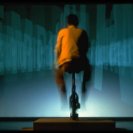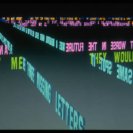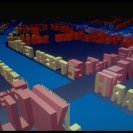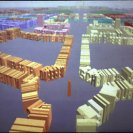In The Legible City the visitor is able to ride a stationary bicycle through a simulated representation of a city that is constituted by computer-generated three-dimensional letters that form words and sentences along the sides of the streets. Using the ground plans of actual cities - Manhattan, Amsterdam and Karlsruhe - the existing architecture of these cities is completely replaced by textual formations written and compiled by Dirk Groeneveld. Travelling through these cities of words is consequently a journey of reading; choosing the path one takes is a choice of texts as well as their spontaneous juxtapositions and conjunctions of meaning.
The handlebar and pedals of the interface bicycle give the viewer interactive control over direction and speed of travel. The physical effort of cycling in the real world is gratuitously transposed into the virtual environment, affirming a conjunction of the active body in the virtual domain. A video projector is used to project the computer-generated image onto a large screen. Another small monitor screen in front of the bicycle shows a simple ground plan of each city, with an indicator showing the momentary position of the cyclist.
The Manhattan version (1989) of this work comprises eight separate fictional story lines in the form of monologues by ex-Mayor Koch, Frank Lloyd Wright, Donald Trump, a tour guide, a confidence trickster, an ambassador and a taxi-driver. Each story line has a specific letter colour so that the bicyclist can choose one or another to follow the path of a particular narration. In the Amsterdam (1990) and Karlsruhe (1991) versions all the letters are scaled so that they have the same proportion and location as the actual buildings which they replace, resulting in a transformed but exact representation of the actual architectural appearance of these cities. The texts for these two cities are largely derived from archive documents that describe mundane historical events there.
Credits:
Software: Gideon May and Lothar Schmitt
Hardware: Tat Van Vark, Charly Jungbauer and Huib Nelissen
In cooperation with the Ministry of Culture of the Netherlands
Exhibitions:
1988: (preview) Het Postmoderne aan Kinderen Verklaaard, Bonnefanten Museum, Maastricht; Museum voor Hedendaagse Kunst, Antwerp, Belgium.
1989: (premier) Artec 89, World Design Expo, Nagoya, Japan; Siggraph 89, Boston, Massachussetts, United States; Ars Electronica: Im Netz der Systeme, Brucknerhaus Linz, Austria.
1990: Time Space Light, Academie Minerva, Groningen, Netherlands; artifices, Saint-Denis, France; artware. Kunst und Elektronik, CeBIT, Hannover, Germany; Interface I, Museum für Kunst und Gewerbe, Hamburg, Germany; Dernieres Visites Avant Travaux, Le Fresnoy, France; De Balie Theater, Amsterdam, Netherlands; L´Immagine Elettronica, Chiesa di San Romano, Ferrara, Italy; Les Artistes et la Lumiere, Centre National Art et Technologie, Reims, France.
1990/91: Vom Verschwinden der Ferne, Telekommunikation und Kunst, Deutsches Postmuseum, Frankfurt am Main, Germany.
1991: MuuMedia Festival, Interaktiviisen Mediataiteen Näytteky, Galleria Otso, Espoo, Finland; MultiMediale 2, ZKM Karlsruhe, Germany; Imago, Video Art Festival, Locarno, Switzerland; El Art, Retretti Art Center, Retretti, Finland; Stanford Conference on Design, Stanford, California, United States.
1992: Moving Image - Electronic Art, Fundaci— Joan Miro, Barcelona, Spain; Virtual World Voyaging: Agnes Hegedüs and Jeffrey Shaw, Art Gallery, Fukuoka, Japan.
1992/93: The Boundary Rider, 9th Biennale of Sydney, Australia.
1993: Die Sprache der Kunst. Die Beziehung von Bild und Text in der Kunst des 20. Jahrhunderts, Kunsthalle Wien, Vienna, Austria.
1995: Art and Electronics, Hong Kong Arts Centre, Hong Kong; Trigon-Personale 95, Neue Galerie Graz, Austria.
1995/96: 3e Biennale d´art contemporain de Lyon, Musèe d´art contemporain, Lyon, France.
1996: Mediascape, Guggenheim Museum Soho, New York, United States.
2000: Gasteig, Munich, Germany;Media Art Festival, St. Petersburg, Russia (in cooperation with the Goethe Institute, Germany).











